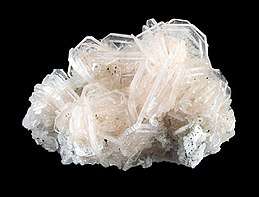Apophyllite
| Apophyllite | |
|---|---|
 | |
| General | |
| Category | Phyllosilicate |
| Formula (repeating unit) | (K,Na)Ca4Si8O20(F,OH)·8H2O |
| Crystal system |
Tetragonal (Fluorapophyllite-(Na) is orthorhombic) |
| Identification | |
| Color | Usually white, colorless; also blue, green, brown, yellow, pink, violet |
| Crystal habit | Prismatic, tabular, massive |
| Cleavage | Perfect on (001) |
| Fracture | Uneven |
| Mohs scale hardness | 4.5 - 5 |
| Luster | Vitreous; pearly |
| Streak | White |
| Diaphaneity | Transparent to translucent |
| Specific gravity | 2.3 – 2.4 |
| Refractive index | 1.536 |
| Pleochroism | Dichroic (colorless) |
| References | [1] |
The name apophyllite refers to a specific group of phyllosilicates, a class of minerals. Originally, the group name referred to a specific mineral,[2] but was redefined in 1978 to stand for a class of minerals of similar chemical makeup that comprise a solid solution series, and includes the members fluorapophyllite-(K), fluorapophyllite-(Na), hydroxyapophyllite-(K). The name apophyllite is derived from the Greek ἀποφυλλίζω apophylliso, meaning "it flakes off", a reference to this class's tendency to flake apart when heated, due to water loss. These minerals are typically found as secondary minerals in vesicles in basalt or other volcanic rocks. A recent change (2008) in the nomenclature system used for this group was approved by the International Mineralogical Association, removing the prefixes from the species names and using suffixes to designate the species.[3] A subsequent nomenclature change approved by the International Mineralogical Association in 2013 renamed the minerals to include both suffixes and prefixes, as shown above.[4]
Though relatively unfamiliar to the general public, apophyllites are fairly prevalent around the world, with specimens coming from some of the world's most well-known mineral localities. These localities include: Jalgaon, India; the Harz Mountains of Germany, Mont Saint-Hilaire in Canada, and Kongsberg, Norway, with other locations in Scotland, Ireland, Brazil, Japan, and throughout the United States.
Species of apophyllite
- Fluorapophyllite-(K) (formerly fluorapophyllite, apophyllite-(KF)), KCa4Si8O20(F,OH)·8H2O - white, colorless, yellow, green, violet[5]
- Hydroxyapophyllite-(K) (formerly hydroxyapophyllite, apophyllite-(KOH)), KCa4Si8O20(OH,F)·8H2O - white, colorless[6]
- Fluorapophyllite-(Na) (formerly natroapophyllite, apophyllite-(NaF)), Na4Si8O20F·8H2O - brown, yellow, colorless[7]
References
- ↑ Apophyllite data on Webmineral
- ↑ Spencer 1911.
- ↑ Burke, E.A.J. (2008): Tidying up mineral names: an IMA-CNMNC scheme for suffixes, hyphens and diacritical marks. Mineral. Rec., 39, 131–135.
- ↑ Hatert, Frederic; Mills, Stuart J.; Pasero, Marco; Williams, Peter A. (2013). "CNMNC guidelines for the use of suffixes and prefixes in mineral nomenclature, and for the preservation of historical names" (PDF). European Journal of Mineralogy. 25: 113–115.
- ↑ Apophyllite-(KF) on Mindat
- ↑ Apophyllite-(KOH) on Mindat
- ↑ Apophyllite-(NaF) on Mindat
- MinDat Listing
- Mineral Galleries
- Colville AA, Anderson CP, Black PM (1971). "Refinement of the crystal structure of apophyllite: I. X-ray diffraction and physical properties". American Mineralogist. 56: 1222–1233.

| Wikimedia Commons has media related to Apophyllite. |